S. M. Zafaruddin
Exact Sum Distribution of alpha-eta-kappa-mu Fading Channels for Statistical Performance Analysis of RRS-Based Wireless Transmission
Feb 18, 2025Abstract:Reconfigurable refractive surface (RRS) is an efficient alternative to holographic multiple input multiple outputs (HMIMO) systems that can serve as a transmission unit operating in the signal refraction mode. RRS transmissions experience near-field propagation due to the proximity of the transmission feed and far-field propagation for the user located farther from the transmitting unit. There is limited research on the effect of channel fading on far-field users in RRS-based transmissions. In this paper, we conduct an exact statistical analysis of RRS-based transmission considering alpha-eta-kappa-mu fading model for the far-field user and the near-field effect of transmission feed. First, we show the exact statistical analysis for the RRS transmission over alpha-eta-kappa-mu fading model consisting of multiple infinite-series representations with multivariate Fox-H function. Next, we develop a novel approach to derive the density and distribution functions for the resultant fading channel of the RRS system in terms of multivariate Fox-H functions without involving infinite series approximations for tractable performance analysis. We present the exact outage probability and average bit-error-rate (BER) performance of single-element and multiple-element RRS systems to validate the proposed analysis further. We also obtain the diversity order of the system by analyzing the outage probability at a high signal-to-noise ratio (SNR). Computer simulations demonstrate the relevance of the developed statistical results for RRS-based wireless systems over the generalized fading model for a comprehensive performance evaluation.
Meijer-G Function with Continued Product and Integer Exponent: Performance of Multi-Aperture UOWC System over EGG Turbulence
Sep 17, 2024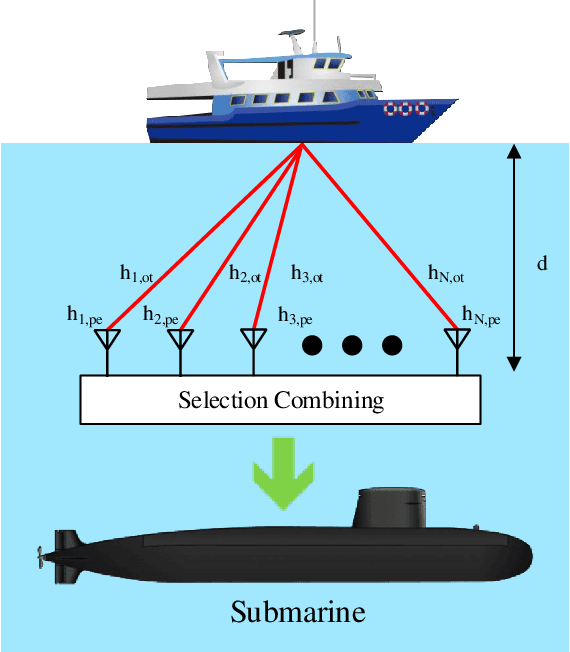
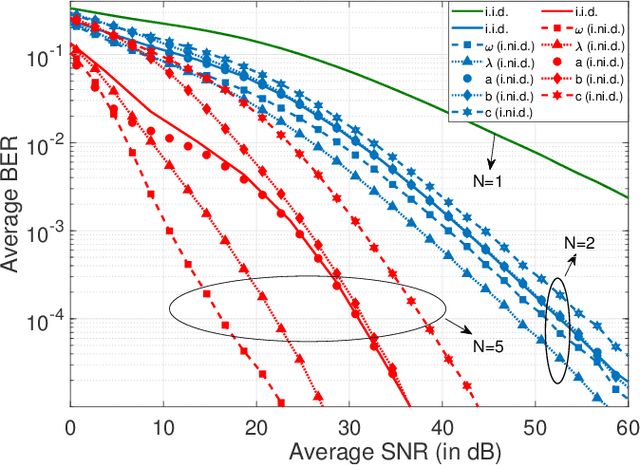

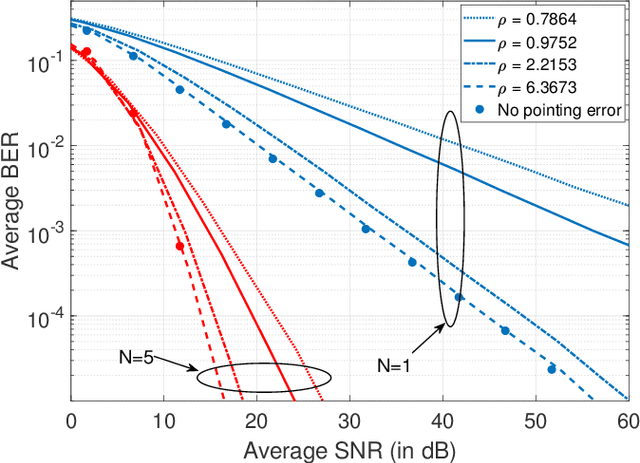
Abstract:Signal transmission over underwater optical wireless communication (UOWC) experiences the combined effect of oceanic turbulence and pointing errors statistically modeled using the sum of two Meijer-G functions. There is a research gap in the exact statistical analysis of multi-aperture UOWC systems that use selection combining diversity techniques to enhance performance compared to single-aperture systems. In this paper, we develop a general framework for the continued product and positive integer exponent for the sum of Meijer-G functions to analyze the exact statistical performance of the UOWC system in terms of multivariate Fox-H function for both independent and non-identically distributed (i.ni.d.) and independent and identically distributed (i.i.d.) channels. We also approximate the performance of a multi-aperture UOWC system with i.i.d. channels using the single-variate Fox-H function. Using the generalized approach, we present analytical expressions for average bit-error rate (BER) and ergodic capacity for the considered system operating over exponential generalized gamma (EGG) oceanic turbulence combined with zero-boresight pointing errors. We also develop asymptotic expressions for the average BER at a high signal-to-noise (SNR) to capture insights into the system's performance. Our simulation findings confirm the accuracy of our derived expressions and illustrate the impact of turbulence parameters for i.ni.d. and i.i.d. models for the average BER and ergodic capacity, which may provide a better estimate for the efficient deployment of UOWC.
Path Loss Modeling for RIS-Assisted Wireless System with Direct Link and Elevation Factors
Feb 16, 2024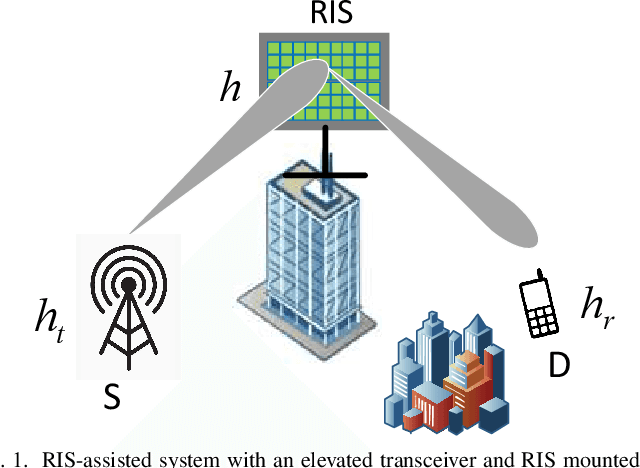
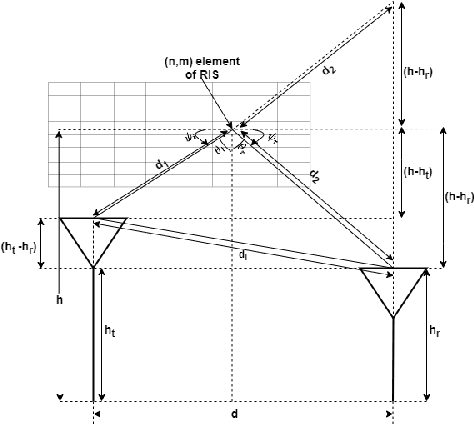
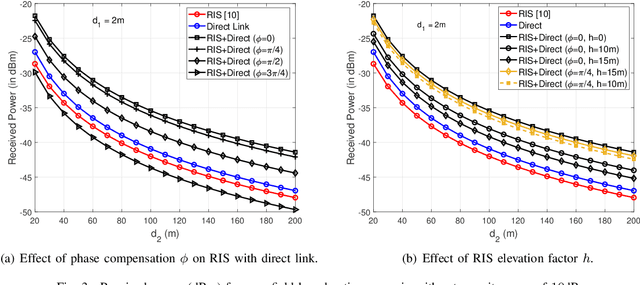
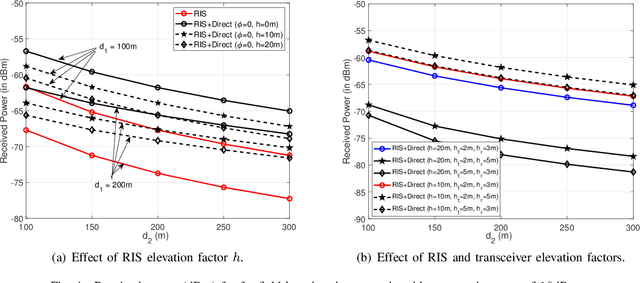
Abstract:The present path loss models for wireless systems employing reconfigurable intelligent surfaces (RIS) do not account for the elevation of the transmitter, receiver, and RIS module. In this paper, we develop an analytical model for path loss of a wireless system utilizing an NxM-element RIS module positioned above the ground surface with elevated transmitter and receiver configurations. Furthermore, we integrate the direct link into the path loss model to enhance its applicability, a crucial aspect often neglected in previous research. We also present simplified analytical expressions for path loss under various configurations, including near-field and far-field scenarios. These expressions elucidate the impact of elevation factors on path loss, facilitating more accurate signal quality estimation at the receiver. Simulation results corroborate that accounting for elevated RIS modules and transceiver units can yield improved deployment strategies for RIS-based wireless systems.
Random Access Protocols for Cell-Free Wireless Network Exploiting Statistical Behavior of THz Signal Propagation
Nov 10, 2023Abstract:The current body of research on terahertz (THz) wireless communications predominantly focuses on its application for single-user backhaul/fronthaul connectivity at sub-THz frequencies. First, we develop a generalized statistical model for signal propagation at THz frequencies encompassing physical layer impairments, including random path-loss with Gamma distribution for the molecular absorption coefficient, short-term fading characterized by the $\alpha$-$\eta$-$\kappa$-$\mu$ distribution, antenna misalignment errors, and transceiver hardware impairments. Next, we propose random access protocols for a cell-free wireless network, ensuring successful transmission for multiple users with limited delay and energy loss, exploiting the combined effect of random atmospheric absorption, non-linearity of fading, hardware impairments, and antenna misalignment errors. We consider two schemes: a fixed transmission probability (FTP) scheme where the transmission probability (TP) of each user is updated at the beginning of the data transmission and an adaptive transmission probability (ATP) scheme where the TP is updated with each successful reception of the data. We analyze the performance of both protocols using delay, energy consumption, and outage probability with scaling laws for the transmission of a data frame consisting of a single packet from users at a predefined quality of service (QoS).
Statistical Results of Multivariate Fox-H Function for Exact Performance Analysis of RIS-Assisted Wireless Communication
Nov 02, 2023Abstract:Existing research provides statistical results on the sum of single-variate Fox-H functions to analyze the performance of diversity receivers and reconfigurable intelligent surfaces (RIS) based wireless systems. There is a research gap in exact performance analysis when more than a single-variate Fox-H function represents the statistical characterization of wireless systems. In this paper, we propose a novel approach to obtain the distribution of the sum of independent and non-identically distributed (i.ni.d) random variables characterized by the multivariate Fox-H function. Further, we develop a general framework for an exact analysis of the ergodic capacity when the multivariate Fox-H function characterizes the statistics of signal-to-noise ratio (SNR). We apply the derived results to conduct an exact performance analysis of outage probability and ergodic capacity, taking an example of RIS-assisted communication over Rician fading channels with phase errors. We conduct computer simulations to validate the exact analysis and demonstrate performance of the RIS-assisted system under various practically relevant scenarios for a better performance assessment.
A Generalized Statistical Model for THz wireless Channel with Random Atmospheric Absorption
Oct 28, 2023Abstract:Current statistical channel models for Terahertz (THz) wireless communication primarily concentrate on the sub-THz band, mostly with $\alpha$-$\mu$ and Gaussian mixture fading distributions for short-term fading and deterministic modeling for atmospheric absorption. In this paper, we develop a generalized statistical model for signal propagation at THz frequencies considering random path-loss employing Gamma distribution for the molecular absorption coefficient, short-term fading characterized by the $\alpha$-$\eta$-$\kappa$-$\mu$ distribution, antenna misalignment errors, and transceiver hardware impairments. The proposed model can handle various propagation scenarios, including indoor and outdoor environments, backhaul/fronthaul situations, and complex urban settings. Using Fox's H-functions, we present the probability density function (PDF) and cumulative distribution function (CDF) that capture the combined statistical effects of channel impairments. We analyze the outage probability of a THz link to demonstrate the analytical tractability of the proposed generalized model. We present computer simulations to demonstrate the efficacy of the proposed model for performance assessment with the statistical effect of atmospheric absorption.
Performance of Integrated IoT Network with Hybrid mmWave/FSO/THz Backhaul Link
Apr 03, 2023Abstract:Establishing end-to-end connectivity of Internet of Things (IoT) network with the core for collecting sensing data from remote and hard-to-reach terrains is a challenging task. In this article, we analyze the performance of an IoT network integrated with wireless backhaul link for data collection. We propose a solution that involves a self-configuring protocol for aggregate node (AN) selection in an IoT network, which sends the data packet to an unmanned aerial vehicle (UAV) over radio frequency (RF) channels. We adopt a novel hybrid transmission technique for wireless backhaul employing opportunistic selections combining (OSC) and maximal ratio combining (MRC) that simultaneously transmits the data packet on mmWave (mW), free space optical (FSO), and terahertz (THz) technologies to take advantage of their complementary characteristics. We employ the decode-and-forward (DF) protocol to integrate the IoT and backhaul links and provide physical layer performance assessment using outage probability and average bit-error-rate (BER) under diverse channel conditions. We also develop simplified expressions to gain a better understanding of the system's performance at high signal-to-noise ratio (SNR). We provide computer simulations to compare different wireless backhaul technologies under various channel and SNR scenarios and demonstrate the performance of the data collection using the integrated link.
Exact Performance Analysis of THz Link Under Transceiver Hardware Impairments
Feb 21, 2023Abstract:Transceiver hardware impairment (THI) is inevitable for high-date rate terahertz (THz) communication. Existing statistical analysis either neglects THI's effect or provides approximate results when analyzing the performance of the THz system combined with channel fading and antenna misalignment. In this paper, we develop exact analytical expressions for the average signal-to-noise ratio (SNR), ergodic capacity, and average bit-error-rate (BER) performance of a THz wireless link under the combined effect of $\alpha$-$\mu$ fading channel, zero-boresight pointing errors, and the Gaussian distributed THI. We also derive asymptotic expressions for the outage probability and average BER, which shows that the diversity order of the THz link is independent of THI's parameters. Simulations validate the derived analytical results and demonstrate the impact of the THI parameters on the THz performance.
Diversity Analysis of Multi-Aperture UWOC System over EGG Channel with Pointing Errors
Dec 19, 2022



Abstract:Single aperture reception for underwater wireless optical communication (UWOC) is insufficient to deal with oceanic turbulence caused by the combined effect of temperature gradient and air bubbles. This paper analyzes the performance of multi-aperture reception for UWOC under channel irradiance fluctuations characterized by the mixture exponential generalized gamma (EGG) distribution. We analyze the system performance by employing both selection combining (SC) and maximum ratio combining (MRC) receivers. In particular, we derive the exact outage probability expression for the SC-based multi-aperture UWOC receiver and obtain an upper bound on the outage probability for the MRC-based multi-aperture UWOC receiver. With the help of the derived results, we analytically obtain the diversity order of the considered multi-aperture UWOC system.
RIS-THz Wireless Communication with Random Phase Noise and Misaligned Transceiver
Nov 16, 2022

Abstract:Existing research works on reconfigurable intelligent surfaces (RIS) based terahertz (THz) system ignores the effect of phase noise and employ the zero-boresight pointing errors model of the free-space optics channel in performance analysis. In this paper, we analyze the performance of RIS-THz transmission under the combined effect of channel fading, THz pointing error (TPE), and statistical phase noise due to imperfect phase compensation at each RIS element. First, we derive statistical results of the double $\alpha$-$\mu$ fading combined with the TPE and phase noise at individual RIS elements using single-variate Fox's function. Next, we use the multi-variate Fox's H-function representation to develop exact analytical expressions for the density and distribution functions of the resultant signal-to-noise ratio (SNR) of the RIS-THz link considering the accumulating propagation effect from all RIS elements. Using the derived statistical results, we analyze the exact and asymptotic expressions for the considered system's outage probability and average bit-error rate (BER). The analytical results show that the diversity order of the system is independent of phase noise, depends on the channel fading parameters $\alpha$ and $\mu$, and depends on the $\beta$ parameter of the TPE.
 Add to Chrome
Add to Chrome Add to Firefox
Add to Firefox Add to Edge
Add to Edge